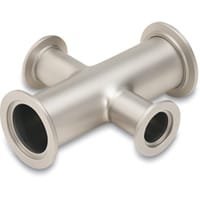KF (QF) HV 4-Way Reducer Crosses
KF (QF) HV 4-Way Reducer Crosses are essential components in high-vacuum (HV) systems, designed to connect four vacuum lines of different sizes at right angles within a single fitting. These crosses enable flexible system configurations, simplify branching in vacuum pipelines, and allow for seamless integration of gauges, valves, or instruments while maintaining vacuum integrity.
Precision Engineering for High Vacuum Applications
Manufactured from high-grade 304 or 316L stainless steel, these 4-way reducer crosses ensure excellent corrosion resistance, mechanical strength, and cleanliness required for vacuum environments. Their KF (also known as QF) flanged ends allow for quick and secure assembly using standard centering rings and clamps, facilitating rapid setup and maintenance in both research and industrial vacuum systems.
Key Features
Connection Type: KF (QF) flanged ends
Configuration: 4-way cross with reducing branches
Material: 304 or 316L stainless steel
Surface Finish: Smooth, vacuum-compatible finish for minimal outgassing
Vacuum Rating: Suitable for high-vacuum conditions (down to 10⁻⁸ Torr)
Size Compatibility: Various flange size combinations (e.g., KF16 to KF40)
Assembly: Tool-free, with quick clamp-style fittings
Typical Applications
Vacuum Instrumentation: Integration of gauges, sensors, and viewports
Research Laboratories: Experimental setups requiring multi-directional flow
Semiconductor Processing: Clean, modular connections for vacuum lines
Analytical Equipment: Gas lines, spectrometers, and beamlines
General Vacuum Systems: Branching lines in pumps, traps, or filter assemblies
Benefits
Reduced Complexity: Combines branching and size reduction in one compact fitting
Time-Saving Design: Quick-clamp mechanism allows fast assembly/disassembly
Reliable Sealing: Leak-tight joints with elastomeric or metal centering rings
Flexible Integration: Compatible with standard KF vacuum hardware
Custom Options Available
TFM offers custom KF (QF) 4-way reducer crosses in alternative sizes, materials (such as aluminum or custom alloys), and vacuum surface treatments (e.g., electropolishing) upon request. Our precision fabrication ensures tight tolerances for leak-free performance in demanding environments.





Reviews
There are no reviews yet.